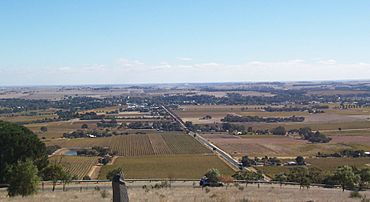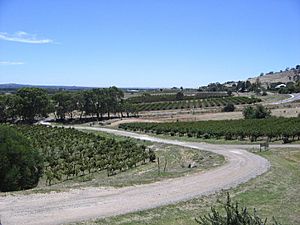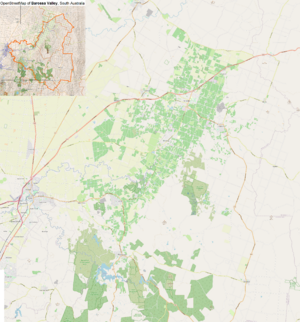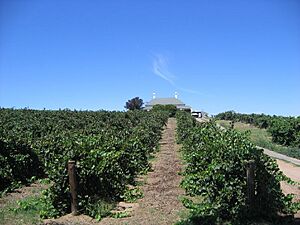Barossa Valley facts for kids
Quick facts for kids Barossa ValleySouth Australia |
|
|---|---|

Autumn colour surrounding Tanunda
|
|
| Population | 25,066 (2021) |
| • Density | 20/km2 (52/sq mi) (approx.) |
| Area | 912 km2 (352.1 sq mi) |
| Time zone | ACST (UTC+9.5) |
| • Summer (DST) | ACDT (UTC+10.5) |
| Location | 60 km (37 mi) NE of Adelaide city centre |
| LGA(s) |
|
The Barossa Valley is a special place in South Australia. It is about 60 kilometers northeast of Adelaide city centre. A river called the North Para River flows through the valley. This area is famous for making wine and is a popular spot for visitors.
The main road through the valley is called the Barossa Valley Way. It connects important towns like Nuriootpa, Tanunda, Rowland Flat, and Lyndoch. There is also a 40-kilometer path called the Barossa Trail. You can walk or cycle on it. It goes past the main towns, from near Gawler to Angaston.
Contents
History of the Barossa Valley

The Peramangk people are the traditional owners of the land in the Barossa Valley. They have lived here for thousands of years. You can still find signs of their history, like old tools, special scar trees, and paintings in shelters.
The Barossa Valley got its name from the Barossa Range. Colonel William Light named it in 1837. He chose the name to remember a British victory in the Battle of Barrosa in 1811. He fought in that battle. The name "Barossa" was written down by mistake. It should have been "Barrosa." The valley is about 13 by 14 kilometers in size.
German and English Settlers
The three main towns in the Barossa Valley are quite different. Tanunda is known for its strong German history. The first German settlers arrived here in the 1840s. Many came from a part of Germany called Silesia. They called the Barossa Neu-Schlesien, which means "New Silesia." The German influence is still strong today.
Angaston is seen as the English town. It was mostly settled by miners from Cornwall and other people from Britain. The biggest town is Nuriootpa. It was influenced by both German and British settlers. Today, it is the main business center of the Barossa. Most of the larger shops are located there.
In 2011, the leader of South Australia, Mike Rann, announced a special law. This law would help protect the unique heritage of the Barossa Valley. He wanted to make sure the Barossa would not become just another suburb of Adelaide. This law, called The Character Preservation (Barossa Valley) Act 2012, was passed to keep the area special.
People and Towns
In 2021, about 25,066 people lived in the Barossa Valley. Most of them live in towns like Tanunda, Nuriootpa, Angaston, Williamstown, and Lyndoch. Each of these towns has over 1,000 people. Other people live in the countryside or in smaller towns like Moculta and Springton. Most of these towns are part of the Barossa local government.
Some towns like Greenock, Seppeltsfield, and Maranaga are on the western side of the valley. They are part of the Light Regional Council. If people in these smaller towns need more services, they often go to nearby Gawler.
Railway and Religion
A railway line, called the Barossa Valley railway line, runs through some towns in the valley. It opened in 1911 but was closed in 2014.
The Barossa region has a strong Lutheran history. Many people living here are Lutherans. Some towns have more than one Lutheran church. For example, Tanunda has four Lutheran churches. Nuriootpa has two, and Angaston has two.
Each major town also has a Lutheran primary school. These include Tanunda Lutheran School, Redeemer in Nuriootpa, and Good Shepherd in Angaston. St. Jakobi, a Lutheran school in Lyndoch, holds the Barossa Airshow every year to raise money.
Major Town Populations
Here are the populations of the major towns in the Barossa Valley from the 2016 Census:
| Rank | Urban Centre | 2016 Census Population |
|---|---|---|
| 1 | Nuriootpa | 5,691 |
| 2 | Tanunda | 4,324 |
| 3 | Angaston | 2,044 |
| 4 | Williamstown | 2,163 |
| 5 | Lyndoch | 1,799 |
| 6 | Greenock | 1,087 |
| 7 | Mount Pleasant | 586 |
| 8 | Springton | 378 |
Many people also live outside these town centers in the countryside.
Wine Industry
The wine industry is very important in the Barossa Valley. It provides many jobs for people living there. The many hectares of vineyards are a key feature of the area. You can see them clearly from the Mengler Hill lookout. This lookout is on the Barossa Range, which forms the eastern side of the valley.
Every two years, the Barossa Valley celebrates its wine success with the Vintage Festival. This week-long event brings visitors from all over the world. It includes a big street parade, concerts, and special food events.
The Barossa Valley is best known for its red wine, especially Shiraz. A lot of Barossa Shiraz is used in Penfolds Grange, which is Australia's most famous wine. Other important grapes grown here include Riesling, Semillon, Grenache, and Cabernet Sauvignon. Stronger, sweet wines called Fortified wines have also been made here for a long time.
Some of the oldest Shiraz grapevines in the world are found in the Barossa Valley. Some vines planted as early as 1847 are still used today by Turkey Flat Vineyards to make wine.
Food Production
Even though wine is very famous, the Barossa Valley also produces a lot of food. This includes:
- Bakeries that make traditional German breads and pastries.
- Butchers who make meat products in the German style.
- Special cheesemakers.
- Maggie Beer is a well-known cook and food producer. Her Farm Shop sells many different food items. She also used to be on an ABC Television show called The Cook and the Chef.
The Barossa Valley also has a weekly Farmers' Market. Here, local farmers sell their fresh produce directly to people.
Festivals
Barossa Vintage Festival
The Barossa Vintage Festival lasts for about a week. It happens every two years in autumn, usually in late March or early April. This festival celebrates the end of the year's grape harvest. Many wine-themed events take place, such as wine tastings, music, food events, and parades.
The first Barossa Vintage Festival was held in 1947. It celebrated the end of the grape harvest and the end of World War II. It is Australia's oldest and longest-running wine festival.
Barossa Gourmet Weekend
The Barossa Gourmet Weekend is a three-day event that celebrates food, wine, and art. It takes place every year on the third weekend of August. Local wineries and other places in the Barossa host their own events. They offer special food, wine, music, art, and a friendly welcome.
In the Arts
A novel about German settlers in the Barossa during World War II is set here.
See also
 In Spanish: Valle de Barossa para niños
In Spanish: Valle de Barossa para niños




